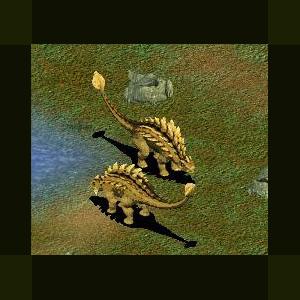About This File
Struthiosaurus (Latin struthio = ostrich + Greek sauros = lizard) is one of the smallest known and most primitive nodosaurid dinosaurs, From the Late Cretaceous period (Campanian-Maastrichtian) of Austria and Romania in Europe.
Originally described in 1871, many species have been referred to Struthiosaurus, most based on very fragmentary and nondiagnostic material.
Three valid species are currently recognized by paleontologists: S. austriacus Bunzel, 1871; S. transylvanicus Nopcsa, 1915; and S. languedocensis Garcia and Pereda-Suberbiola, 2003. Along with Hungarosaurus Osi, 2005, Struthiosaurus is currently one of only two valid members of the Ankylosauria known from Europe. A number of invalid taxa have been shown to be junior synonyms of Struthiosaurus, including: Crataeomus Seeley, 1881; Danubiosaurus Bunzel, 1871; Pleuropeltis Seeley, 1881; and Lepisanosaurus Nopcsa, 1918. Another European ankylosaurid, Rhodanosaurus Nopsca, 1929, from Campanian-Maastrichtian-age rocks of southern France, is now regarded as a nomen dubium and referred to Nodosauridae incertae sedis.
The three valid species of Struthiosaurus differ from one another in that S. austricus is smaller than S. transylvanicus and possesses less elongate cervical vertebrae. Also, though the quadrate-paroccipital process contact is fused in S. transylvanicus, it is unfused in S. austricus. The skull of S. languedocensis is presently unknown, but the taxon differs from S. transylvanicus in the shape of the dorsal vertebrae. It differs from S. austricus in the shape of the ischium. (Vickaryous, Maryanska, and Weishampel 2004)
Some workers (Vickaryous, Maryanska, and Weishampel 2004) consider the assignment of Struthiosaurus to the Nodosauridae to be provisional, pending further study and future discoveries
Cladistic analysis of Struthiosaurus (Osi, 2004) indicates that the taxon is a basal member of the Nodosauridae and suggests it may be one of the most basal ankylosaurs in the clade Ankylosauria.



Recommended Comments
There are no comments to display.
Create an account or sign in to comment
You need to be a member in order to leave a comment
Create an account
Sign up for a new account in our community. It's easy!
Register a new accountSign in
Already have an account? Sign in here.
Sign In Now